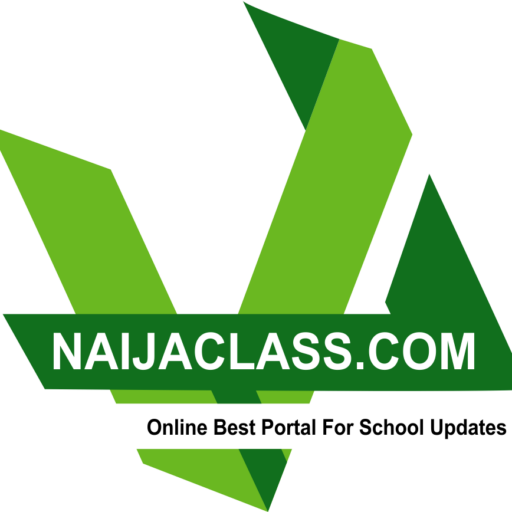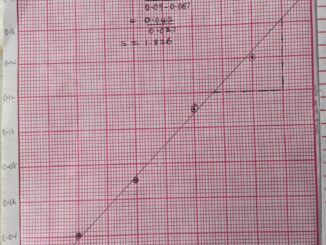Welcome to “Naijaclass Academy” On How to Get Waec 2024 Economics Answer
Date: Tuesday, 4th June, 2024
Economics (Essay & Objective) 9:30 am – 12:30 pm
——————————
ECONOMICS OBJ
01-10: BDBCABDADC
11-20: CDBDDACABD
21-30: CBCBDAADBC
31-40: CBADCDCDAD
41-50: BCABCDABCC
COMPLETED
=====================================================================
SECTION A (Answer 1 Question Only)
NUMBER 1
(1ai)
The equilibrium price before the tax is $80.
(1aii)
At the equilibrium price of $80 (where S₀ intersects D), the quantity demanded and supplied is 60 units.
(1aiii)
The new equilibrium price is $100.
(1aiv)
At the new equilibrium price of $100, the quantity demanded and supplied is 54 units.
(1bi)
-Price after tax = $100
-Sellers receive = $75 (where S₁ intersects the original supply curve S₀ at the new quantity)
Tax per unit = $100 – $75 = $25
(1bii)
The amount retained per unit by the sellers after tax is the price that sellers receive after tax. This is where the new supply curve (S₁) intersects the original supply curve (S₀) at the new quantity of 54 units, which is $75.
(1ci)
-Buyers pay more than the original price after tax.
-Increase in price for buyers: $100 (price after tax) – $80 (price before tax) = $20
Percentage of the tax paid by buyers per unit:
(Buyer’s portion of the tax)/(total tax) × 100
(20/25) × 100 =80%
(1cii)
-Sellers receive less than the original price after tax.
-Decrease in price for sellers: $80 (price before tax) – $75 (price after tax) = $5
Percentage of the tax paid by sellers per unit:
(Seller’s portion of the tax)/(total tax) × 100
(5/25) × 100 =20%
Number 1C
Price before tax: $80
Price after tax: $100
Price retained by sellers after tax: $75
Tax per unit: $25
The total tax is $25. We see that:
i. Buyers pay an additional $20 per unit ($100 – $80).
ii. Sellers receive $5 less per unit ($80 – $75).
NUMBER 2
SECTION A (Answer Any 3 Question Only)
NUMBER 3
(5a)
(i) Labour force: The labour force refers to the number of people employed or actively seeking work in a country, excluding children, retirees, and those unable to work.
(ii) Over-population: Over-population occurs when a country’s population exceeds the available resources, leading to issues like unemployment, poverty, and strain on infrastructure.
(iii) Mobility of labour: Labour mobility refers to the ability of workers to move freely between jobs, industries, and locations in search of better opportunities.
(iv) Optimum population: Optimum population is the ideal number of people that a country can support, balancing resource availability and economic growth.
(5b)
(i) High Birth Rate: Large families and a high number of children per family contribute to population growth.
(ii) Improved Healthcare: Advances in medicine and healthcare lead to lower mortality rates and increased life expectancy.
(iii) Increased Food Supply: Improved agricultural productivity and food availability reduce starvation and malnutrition, contributing to population growth.
(iv) Migration: Inward migration from other countries or regions can significantly contribute to population growth.
========================================
(4a)
Distribution refers to the process of getting a product from its point of production to the end consumer. It involves various activities such as transportation, storage, and selling, aimed at making the product available to the target market in the right quantity, at the right place, and at the right time.
(4b)
[PICK ANY THREE (3)]
(i)He sells in small quantities to consumers:The retailer purchases in small quantities from the wholesaler and breaks the goods down into units for the customers.
(ii)He provides after-sales services:He provides after-sales services like installation, repairs and servicing to the consumer.
(iii)He grants credit facilities to the consumers:The retailer can grant credit facilities to the consumers so as to enable them enjoy goods without payment immediately.
(iv)Stock variety of goods:The consumers can buy varieties of goods from the retailers,hence they are exposed to a wide range of goods.
(v)He supplies information to the wholesaler and manufacturer:The retailer is in the best position to collect information and feedback about the market,as well as the needs of the customers and makes it available to the wholesaler and manufacturer
(vi)He sells at convenient locations and hours:The retailers sells goods to the consumers at any time of the day and at convenient places
(4c)
[PICK ANY THREE (3)]
(i)Longer channel of distribution:The wholesalers and retailers make the channel of distribution of goods longer.
(ii)Creation of artificial scarcity:The wholesalers and retailers normally create artificial scarcity of products through hoarding.
(iii) Increase in prices:The middleman also cause unnecessary price increase to the dismay of the final consumer
(iv) Misinformation:The middleman sometimes misinform the consumers.
(v) fluctuation of prices:The middleman can also cause price fluctuation, especially when too many of them are involved in distribution of products
(vi)Disguised unemployment:The presence of wholesalers could encourage large scale disguised unemployment
=====================================
(6a)
(i) Industrialization: The process of transforming an economy from primarily agricultural to one dominated by industry, characterized by the development of manufacturing, infrastructure, and technological advancements.
(ii) Mineral resources: Naturally occurring inorganic substances with economic value, such as metals, ores, and minerals, extracted from the earth’s crust.
(6b)
(i)Generation of foreign exchange earnings through exports.
(ii)Creation of employment opportunities in the mining sector.
(iii)Increased government revenue through royalties and taxes.
(6c)
(i)Improved standard of living through increased access to goods and services.
(ii)Diversification of the economy, reducing dependence on a single sector.
(iii)Development of infrastructure, such as roads, energy systems, and transportation networks.
=====================================================================
(7a)
(PICK ANY ONE)
A Central Bank is a government-owned or controlled institution responsible for regulating a country’s monetary policy, maintaining financial stability, and supervising the banking system. Examples of Central Banks include the Federal Reserve in the United States, the Bank of England in the United Kingdom, and the Central Bank of Nigeria.
OR
A central bank is a government-owned or independent entity responsible for overseeing a country’s monetary policy, regulating its financial system, and maintaining financial stability.
(7b)
(PICK ANY THREE)
(i) Open Market Operations (OMO): Selling government securities on the open market to absorb excess liquidity and reduce money supply.
(ii) Increase in Reserve Requirement: Raising the minimum reserve requirement for commercial banks, forcing them to hold more reserves and reduce lending, thereby reducing money supply.
(iii) Increase in Interest Rates: Raising interest rates to make borrowing more expensive, reducing demand for loans, and decreasing money supply.
(iv) Sale of Government Bonds: Selling government bonds to absorb excess liquidity and reduce money supply.
(v) Moral Suasion: This is the act of using persuasion and influence to encourage commercial banks to reduce lending and curb money supply.
(7c)
(i) Banker to the Government:
The Central Bank acts as the government’s bank, providing services such as: Managing government accounts, Handling government finances, Advising on economic policy, Implementing monetary policy.
(ii) Banker to Commercial Banks:
The Central Bank acts as the bank for commercial banks, providing services such as: Holding reserve deposits, Providing liquidity, Supervising and regulating banking activities, Acting as a lender of last resort.
(iii) Lender of Last Resort:
The Central Bank acts as the lender of last resort by providing emergency loans to commercial banks facing liquidity crises, preventing bank failures and maintaining financial stability.
===========================================
(8a)
(PICK ANY ONE)
Economic development is the persistent growth in real per capital income coupled with structure changes in the economy which results in an improvement in the standard of living of the citizens.
OR
Economic development refers to a sustained and sustainable increase in the production of goods and services in an economy, accompanied by an improvement in the overall standard of living of the population.
(8b)
(PICK ANY THREE)
(i) Low per capita income: The average person in a developing country earns a relatively low income, which limits their ability to save money, invest in education or healthcare, and afford basic necessities like food, water, and shelter.
(ii) High population growth rate: Developing countries often experience rapid population growth, which can put a strain on resources, infrastructure, and services like healthcare and education. This can lead to a large youth population and a significant dependency ratio.
(iii) High rates of unemployment: Many people in developing countries are unable to find stable, well-paying work, leading to high levels of unemployment and underemployment. This can contribute to poverty, inequality, and social unrest.
(iv) Dependence on the primary sector: Developing countries often rely heavily on agriculture, mining, or other extractive industries, which can make them vulnerable to fluctuations in global commodity prices and leave them exposed to environmental degradation.
(v) Dependence on exports of primary commodities: Many developing countries rely heavily on exporting raw materials or primary products, such as cotton, coffee, or oil, rather than manufactured goods or services. This can limit their economic diversification and make them vulnerable to external shocks.
(vi) Low levels of living: Developing countries often struggle with poor living standards, including inadequate access to healthcare, education, sanitation, and clean water. This can lead to high rates of poverty, malnutrition, and infant mortality.
(8c)
(PICK ANY THREE)
(i) Investing in Human Capital: Investing in education, healthcare, and training programs to develop a skilled and productive workforce. This can lead to increased productivity, innovation, and competitiveness.
(ii) Encourage Investment in Infrastructure: Invest in building modern transportation networks, communication systems, and energy infrastructure to facilitate trade, commerce, and industrial development.
(iii) Promoting Trade and Export-Led Growth: Implement policies to increase trade and exports, such as reducing tariffs and other trade barriers, promoting foreign investment, and developing export-oriented industries.
(iv) Foster a Favorable Business Environment: Create a business-friendly environment by simplifying regulations, reducing bureaucracy, and promoting entrepreneurship and innovation. This can encourage startups, attract foreign investment, and stimulate economic growth.
(v) Develop Strategic Industries: Identify and develop strategic industries that have the potential for high growth and employment creation, such as technology, manufacturing, or tourism. Provide incentives and support to encourage investment and innovation in these industries.
=================================================================









I have not seen answer
I have not seen answer
Thank u have seen it
Thank u have seen it
I love this everything is correct keep the good work
Thanks Adejare eniola
I love this everything is correct keep the good work
Thanks Adejare eniola
no pdf?
no pdf?
This waec quesion is it for 2024 set
This waec quesion is it for 2024 set
Please is it for 2025
Please is it for 2025